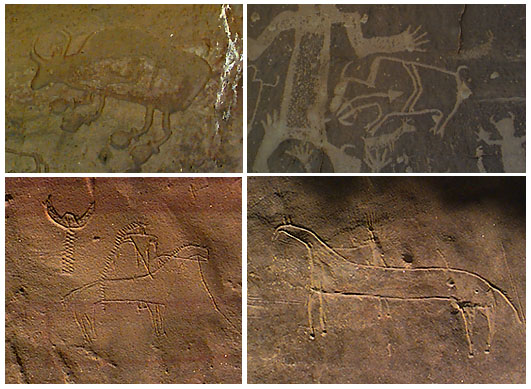

   
|
We're headed for our final destination- La Junta, Colorado.
Before we begin inspecting the inscriptions at this location, there is another type of Indian petroglyph that you should be familiar with- that of the Plains Indians.
The Four Corners Expedition was initiated by our invitation to visit an area in southeast Colorado, where a group of scientists have discovered evidence of a foreign civilization who used an alphabet similar to an extinct language last seen around 500 B.C. in Arabia. Obviously this does not fare well for believers in Christopher Columbus or Leaf Erikson and their claim to "discovering" America.
In fact, the continent of North America was likely discovered by the ancestors of todays Native Americans, who migrated here from Asia. We see tantilizing evidence that these indiginous people were visited by sea-farers from both the East and West, and that a variety of cultural traits from these areas were incorporated into the Native American culture. Most of the evidence for this has been speculative and centered around a few small artifacts and a great deal of imagination. The Colorado discovery is different.
In preparation for this discovery, we have taken you to see many of the outstanding petroglyphs made by Native Americans in the Southwest. We have seen small figures of birds and goats with horns repeatedly pecked into the weather walls of canyons, and these have been attributed to clan markings (see bird petroglyph below). We have also seen various sun symbols and stylized human and animal forms carved into the blackened rock faces of the Hopi Sunpark. Some of these were clan marks as well, but others appear to be stories that used symbols and shapes that were well understood by their creators.
In his book, The Rocks Begin To Speak, which we will mention later in detail, LaVan Martineau has successfully translated the meaning of these various shapes and figures. His crowning success was the translation of the Kit Carson campaign, as recorded in petroglyph form, which appeared earlier in our expedition. Martineau has also discovered that the Hopi used these same universal symbols to detail their snake dance, a ritual usually performed in the late autumn to solicit rain for the maturing corn.

We Quote from Martineau's book:
The sipapu is very common in Hopi ceremonies, and is still used in the Snake Dance, where it is represented by a hole dug in the dance arena and covered with a sounding board. The dancers stomp on this board each time they circle the arena with a different snake.
Symbols a and b clearly indocate the sipapu. Symbol a is the spirit coming out, indicated by its body and arm protruding outside the covering, as if in the act of emerging.
Symbol c is a man stomping on the sounding board over the sipapu, and symbol d represents the circuit made around the arena with each snake before it is freed (e).
Symbol f is an accompanying dancer who makes the circuit each time to help guide the one holding the snake..."
I would recommend Martineau's book, The Rocks Begin To Speak (Library of Congress 72-85137) and an additional book, Ancient American Inscriptions: Plow Marks or History? by William R. McGlone et al. (ISBN 0-10953-65-xxx). The latter will be available on this web site shorty.
In general, the Plains Indian petroglyphs and pictographs appear ro have been drawn in pictoral symbols, or representational form. As most of the Native American languages were not written, these symbols seem to act more as reminders to the story tellers who would embellish the story with important, memorized details and lessons. Symbols also appear in combined form to make compound meanings.
 In one early pictograph at Mystery Valley, we saw the symbol for "war" (two arrows pointing at each other), combined with a circle, "holding" and gave a possible explanation of the phrase "holding war" as a meaning. To the right, the horizontal line or "trail" symbol is combined with the pictograph for "temple" or "gathering place", possibly meaning that the inhabitants had moved to the populated area. The Plains Indian art we will be encountering in Colorado will be similar. It will contain numerous clues as to the recent origin of these markings, such as the depiction of horses (brought by the Spanish in the 1600's) and of White Men (usually depicted with cowboy style hats) and rifles. We mention this because these petroglyphs were often drawn on the same stone walls as the much earlier abstract art and, most importantly, the alphabetical writing that we will be examining. Some prime examples of Plains Indian petroglyphs are shown below. Note that they seem to be inscribed or scratched into the rock rather than pecked, as many of the older glyphs are made. 
We invite you to explore the petroglyphs of the Pergatoire River area in Southeast Colorado, also known locally as the Picketwire valley near La Junta. The petroglyphs in this unique area are both Native American and a much older style that has been interpreted as a form of writing by an unknown people. In 1998, Viewzone Magazine conducted an exclusive expedition to this area, photographing the petroglyphs and documenting the location of many interesting archaeological sites. We returned again in 2000 and 2001 and successfully translated many of the carved inscriptions, relating them to similar petroglyphs found in Asia and also Australia. Although this work is controversial, we invite you to examine the reports and make up your own mind about this amazing phenomenon. |